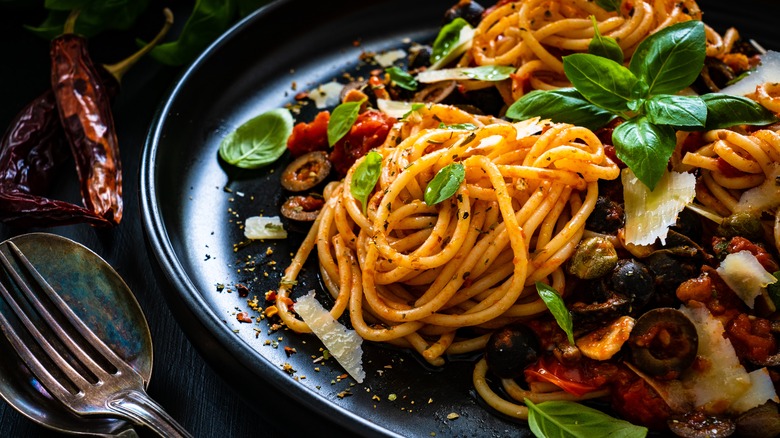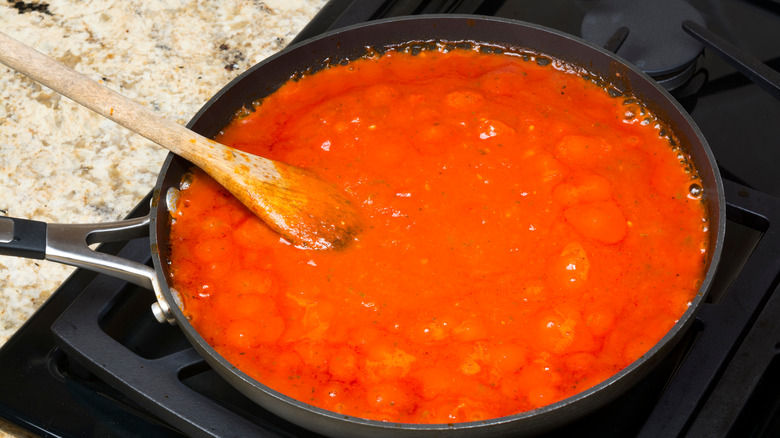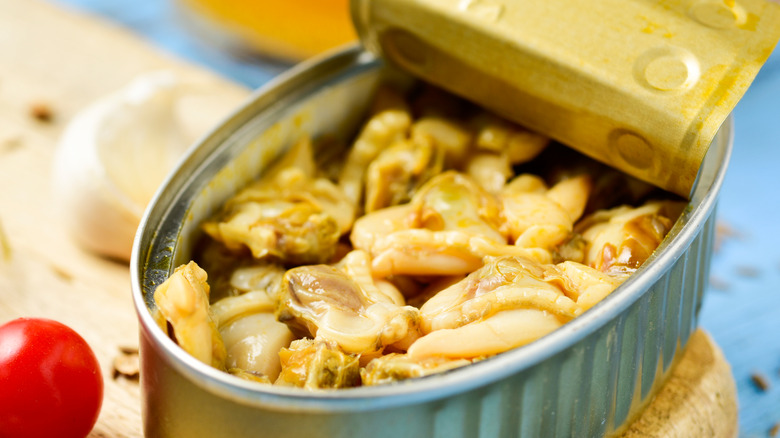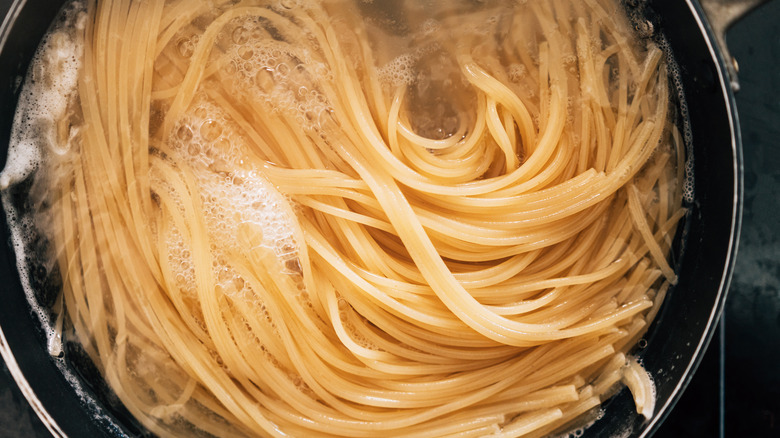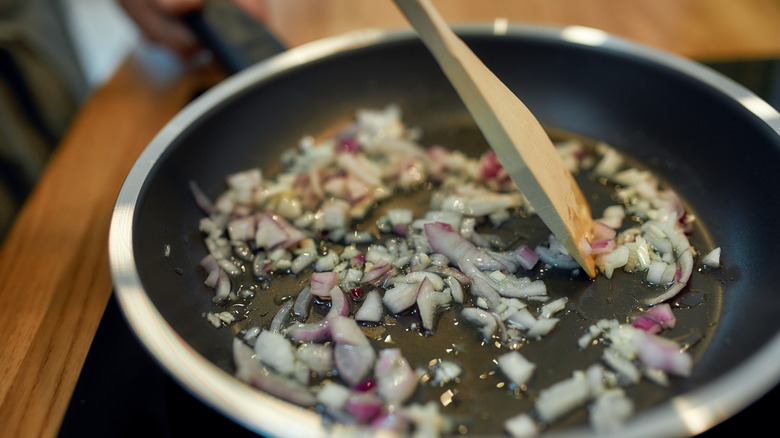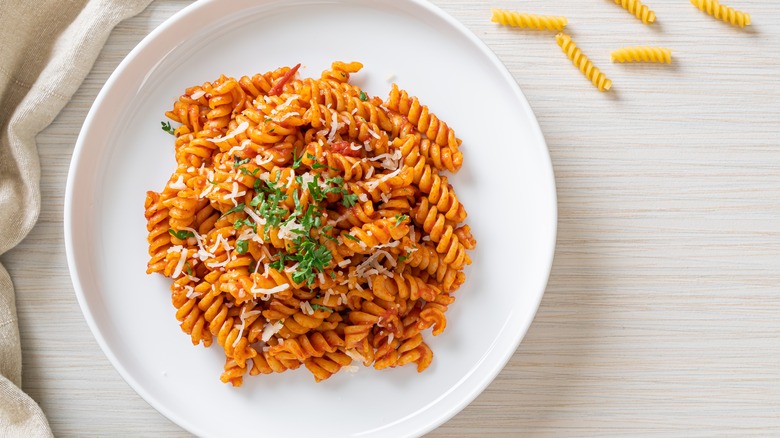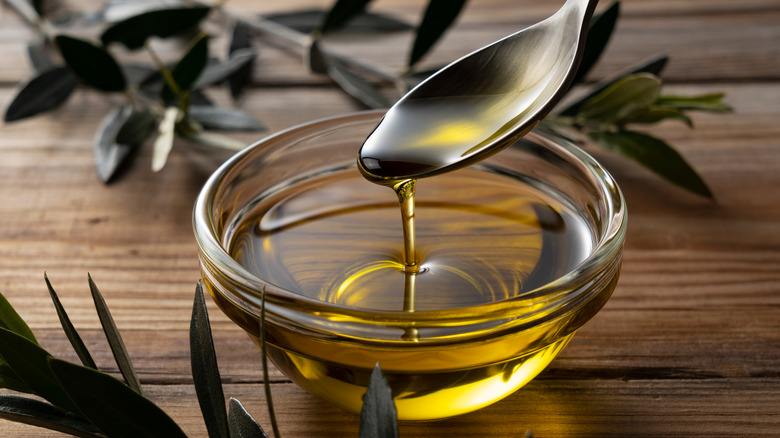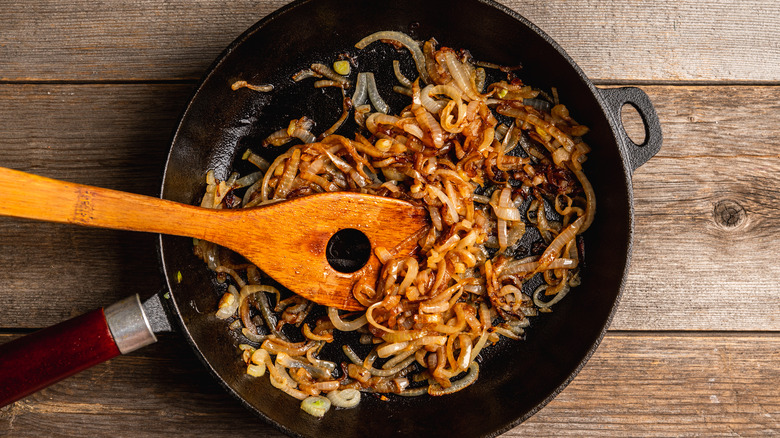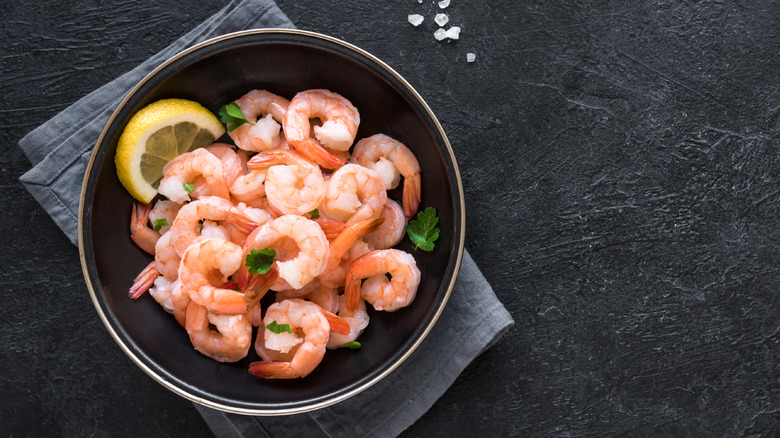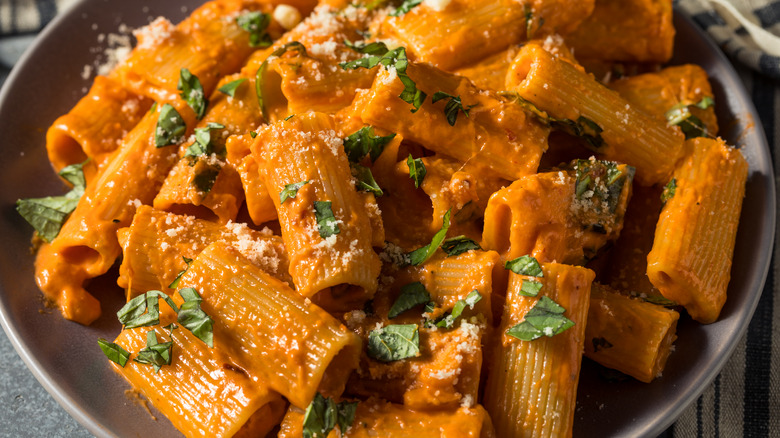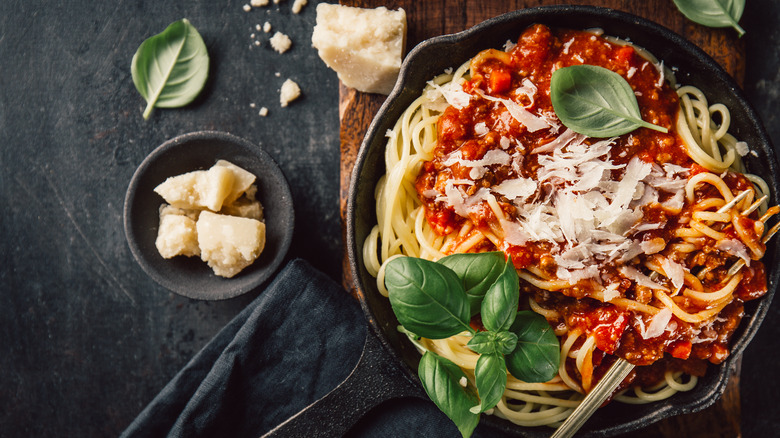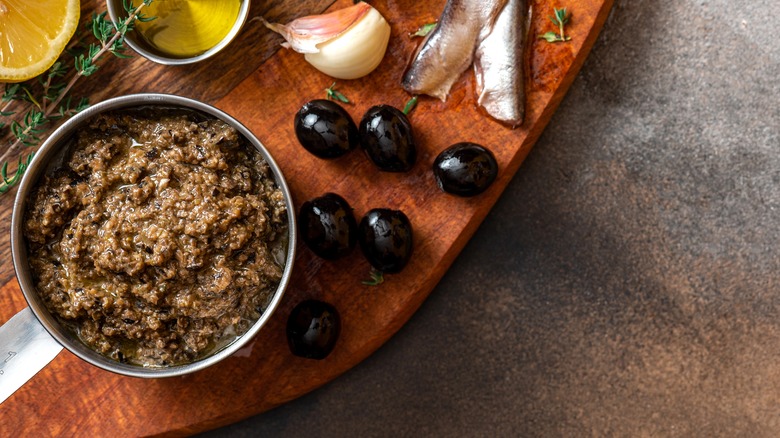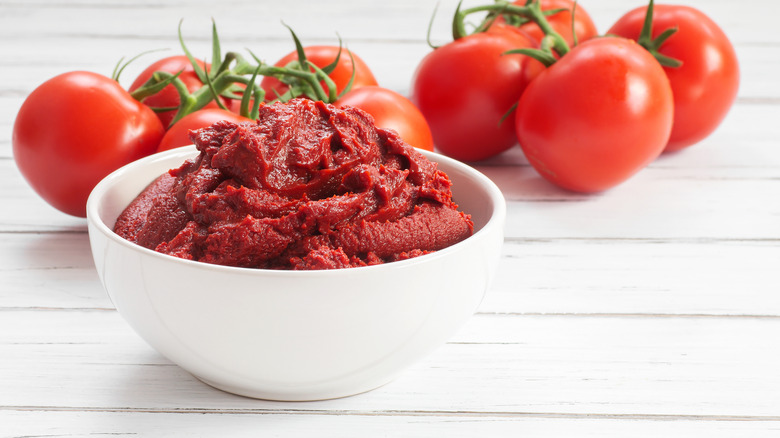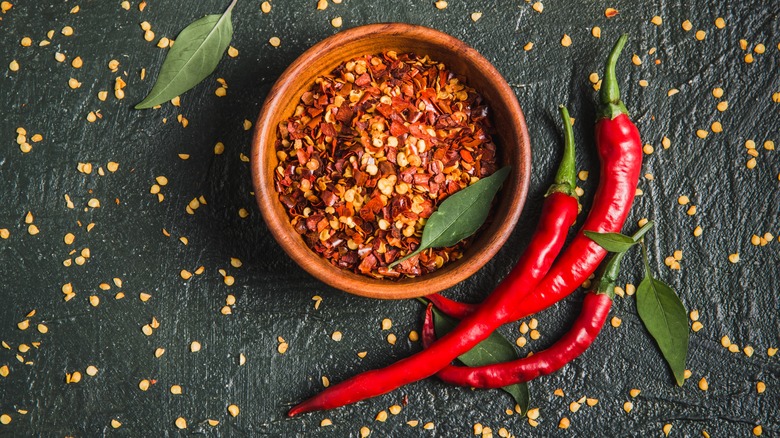15 Ways To Make Jarred Tomato Sauce Taste Homemade
The aroma of garden tomatoes, freshly picked basil, and crushed garlic is enough to make anyone dizzy. And everyone knows there's nothing better than a slow simmered, delicately seasoned, freshly made marinara. But sometimes the pasta gods are calling, and you just don't have time to start from scratch, and we don't blame you. There are actually some pretty incredible store-bought pasta sauces out there that are worth a try and will probably have you coming back for more. That being said, there is just something about marinara with a unique, homemade flair, so a great way to compromise is by starting with a store-bought base and adding some specialty ingredients to make it your own. Luckily, the options are endless when it comes to ways to make jarred tomato sauce taste homemade.
Whether you're targeting grandma's secret recipe, a meat-rich bolognese, or a super sweet slow cooker sauce, there are ways to achieve your goals without starting with a grocery bag full of vegetables. With a dash of creativity, the ability to think outside of the box, and a jar of your favorite pre-made tomato sauce, you can enjoy deliciously flavored pasta in just minutes.
Cooking it down
One of the reasons that your store-bought tomato sauce may be less sweet than the homemade version is more acidity. This could be due to the ingredients, preservation methods, or the fact that it has not had the chance to cook down. Tomatoes are loaded with sugars but are naturally acidic. In order to cook away the acidity and bring out the natural sweetness of the fruit, it's important to simmer the sauce for as long as possible. Think of the processes as similar to reducing balsamic; the acidity of the vinegar cooks out, leaving behind a sweet syrup.
Start by simmering your jarred tomato sauce in a wide saucepan on medium heat until it starts to bubble. If the sauce is already quite thick, go ahead and add a little water or vegetable broth. Let it simmer on low heat for at least 30 minutes, but for an ultra-sweet sauce, cook it until it's reached your desired flavor. Add liquid as needed, but oftentimes store-bought sauces are fairly thin, to begin with anyway.
Splash in some balsamic vinegar
Ever buy a jar of store-bought tomato sauce and notice it's loaded with sugar? We aren't talking about those natural caramelized sugars found in slow-roasted tomatoes; we mean added refined sugar that takes sauce from subtle and rustic to sweet and cheap tasting. Luckily, there is a simple way to fix overly sweet tomato sauce. Just like we cook acid out of sauce to make it sweeter, the best way to tone down the sugar is by adding a little acidity to the sauce.
While some vinegars are fairly sweet, the acidity should help to balance the sweet tones and boost the overall flavor. Try using lemon juice, apple cider vinegar, white vinegar, or even balsamic. Fruit-flavored balsamic like fig or pomegranate tend to be fairly sweet, so stick to the originals. If you plan to simply heat the sauce before spooning it over pasta, then feel free to add the vinegar at any point. If you are slow cooking it, then add the vinegar or citrus juice closer to the end of the cooking process. Reduced vinegar is fairly sweet, so if the goal is to balance the flavor, then it's important to keep some of the acids whole instead of cooking them off.
Fold in canned clams
Linguine alle vongole is a popular Italian dish that can be made with both a red sauce and a broth-based sauce. The star of the show is canned clams, which is a flavorful seafood you should be adding to tomato sauce. We've suggested the canned version because not only are they easier to source, but they come in a briny juice that can elevate any jarred tomato sauce. Plus, isn't the goal here simplicity?
As with most seafood, clams pair beautifully with a lighter sauce rather than a robust thick sauce that may overpower their delicate flavor. Once the jarred tomato sauce is heated, add the full can of clams, juice, and all. The brine will produce a saltier, tangier sauce and act as a broth to thin out the tomatoes. Canned clams have a slightly sweet flavor and, of course, have seafood undertones. Their chewy yet tender texture helps to break up the monotony of the red sauce and complements al dente pasta beautifully.
Save some of the salted pasta water
If your pasta water is thin and clear, then you may want to question how much pasta water you should be using to cook your pasta. Most chefs agree that about four quarts per pound should do the trick, but a little more won't hurt anything. Before you pour all of that starchy water down the drain, consider saving some of it to add to your sauce.
Pasta water, especially when salted, can be a nice addition to jarred pasta sauce because it can improve the texture by thickening it and helping the pasta and sauce bind together. Often, jarred sauce can be a bit watery and not quite as rich or creamy as the homemade version, and even a few tablespoons can make all the difference. This even works well with pasta alternatives like chickpea pasta, brown rice pasta, pea pasta, and lentil pasta, which are all just as starchy, if not even more so.
Stir in some roasted aromatics
The simplest way to bring out the flavor in jarred tomato sauce may seem like a no-brainer. Aromatics like garlic and onions are what give tomato sauce an unforgettable sweet and punchy kick. As any home cook knows, the addition of roasted garlic can bring almost any dish from bland and boring to powerful and memorable. In this case, there can't be too much of a good thing. There are several ways to sneak in more garlic and onions to your sauce, but the simplest way is by sprinkling in granulated garlic and onion.
A fresher, more flavorful option would be to sauté your aromatics in a little bit of olive oil until they are fragrant. And finally, if you have a little extra time on your hands and want your kitchen to smell incredible, simply roast garlic in the oven. Grab a whole heat and cut off the top to expose the cloves. Drizzle it with olive oil and wrap it in tin foil. Bake at 375 degrees Fahrenheit for 45 minutes, let it rest, and then carefully squeeze out the mushy roasted garlic paste from the flakey exterior right into your sauce. Enjoy elevated tomato sauce that tastes almost homemade.
Incorporate fresh herbs
It's very likely that your store-bought marinara is loaded with herbs and spices, but there's nothing like minced, fresh herbs to elevate your dish. Any five-star restaurant will agree that freshly picked basil, oregano, and parsley have a more distinct flavor than the dried version, which could be sitting on a shelf for months or even years before use. And if we are being honest with ourselves, we all know that a sprinkling of fresh greenery on top of a big bowl of pasta just makes it all the more aesthetically pleasing and desirable.
If you don't have fresh herb plants at home, don't worry. Most stores will sell fresh basil and parsley. Be sure to wash the herbs in cold water thoroughly and then mince them with a sharp knife to avoid bruising. You can either cook the herbs right into the sauce or use them as a flavorful garnish. Both have a refreshing flavor, basil being sweeter and parsley having citrus undertones. Top with freshly cracked black pepper, and you'll have a five-star plate of pasta staring back at you that took only minutes to throw together.
Finish with EVOO
Olive oil is not just an ingredient used for sautéing veggies or mixing with lemon or balsamic to make a salad dressing. It is an incredibly flavorful ingredient that changes the flavor, texture, and composition of a dish with just a few drops. High-quality extra virgin olive oils are often used to finish dishes as a garnish. Although there is likely quite a bit of oil in jarred sauce already, EVOO should be added once the pasta and sauce are plated as a light drizzle.
The higher quality of the extra virgin olive oil, the better. Although it may be expensive, spring for a fresh bottle that was processed and shipped or imported as recently as possible. Just be sure not to savor it too much at risk that it will expire. A fresh, high-quality EVOO should have a floral, peppery flavor with slightly bitter undertones. It will pair beautifully with any store-bought sauce and certainly take it up a notch.
Mix in sautéed onions in butter
While butter might not be the first thing that comes to mind when someone lists ingredients for tomato sauce, it has a creamy, rich depth to it that can make any thin, bland store-bought sauce sparkle. Instead of adding butter right into the sauce, mince or dice sweet onion and slow-cook it in a tablespoon or two of the creamy fat until they become translucent and begin to caramelize.
The combination of caramelized onion with butter is incredibly sweet and rich and can add an additional layer of flavor to any sauce. Often, standard brand-name tomato sauces lack that richness and heavy mouthfeel. Both butter and onions can help balance that by adding fat, along with salty and sweet undertones. Vegans can opt for a high-quality vegan butter, but taste it before adding it, as many plant butters have a strong flavor you may not want to incorporate into the sauce.
Don't throw out shrimp tales
We love a home cook who just can't seem to get rid of vegetable skins and chicken bones without repurposing them into a tasty meal. And why waste something useful? Next time you make a shrimp cocktail or scampi, don't let those tails go down the garbage disposal. Instead, once your pre-made marinara sauce hits the stovetop, toss them right in. This is the unconventional ingredient that will add a deeper flavor to tomato sauce.
This flavor is similar to that of sauce with anchovies, which is also quite popular. These tails boost the umami flavor that rich tomatoes also provide. This little life hack may easily become the secret ingredient that guests just won't be able to put their finger on. Just be sure to remove them before you serve your dish, and warn anyone with a crustacean or seafood allergy that might be enjoying your delicious pasta sauce.
Make vodka sauce by adding heavy cream
Calling all penne alla vodka fans! For those of you who enjoy indulging in decedent pasta dishes, it's time to start considering this simple addition for creamier jarred tomato sauce. This is perhaps one of the fastest ways to transform pasta marinara into something unique and crave-worthy. All you need is heavy cream to transform your tomato sauce into an entirely different dish. Start with a few tablespoons of cream per jar of marinara, and add more as desired. A little bit can go a long way, and there is no way to backtrack unless you're willing to pop open a whole new jar of sauce.
If dairy doesn't sit well with you, or you're looking for a vegan alternative, consider using cashew cream in your cooking. Simply soak raw cashews until soft, and blend them with water until creamy. You should strive for the consistency of heavy cream. Be sure to keep that sauce moving while it's heating up to prevent it from sticking to the bottom of the pan.
Add a splash of fish sauce
When it comes to boosting the flavor of jarred marinara sauce, sometimes it pays to think outside of the box. Often, store-bought tomato sauces taste like they are missing something, but it may be hard to put your finger on just what that might be. A rounded umami flavor is a way to add depth to any dish, and there are a few ways to get there. The ingredient that will change your tomato sauce forever may come as a surprise, but fish sauce can help to finish the mouthfeel of even a cheap sauce.
Fish sauce is typically made with salty fermented anchovies and can be found with variations all around the world, including the Mediterranean, although it's often associated with Asian cuisine. While fermented fish sounds rather potent, and not in a good way, it has an almost sweet and briny flavor that hits all the marks. For vegans or vegetarians craving that rounded umami flavor, try a vegan fish sauce typically made with shiitake mushrooms.
Grate a little parmesan cheese on top
Although the suggestion to grate fresh parmesan cheese over pasta with red sauce isn't totally original, it deserves some recognition. This dynamic duo has been complementing each other for a long time, and there is a very good reason for that.
Parmesan cheese has a strong, unique flavor and texture that can take jarred tomato sauce up a peg. It's slightly gritty in texture and quite dense and has a nutty yet fruity taste. Parmesan is firm and tends to hold its form, even when grated over hot pasta and sauce. Most importantly, parmesan is salty and carries a strong umami flavor which can add depth. As perhaps one of the most common and simplest solutions to enhancing a bland store-bought tomato sauce, it can be used on its own or in combination with any of the suggestions listed. Parmesan cheese is not vegetarian and contains animal rennet, so be sure to alert any of your herbivore friends before serving it up at your next dinner party.
Dollop on some tapenade
As we know, olive oil is the perfect finisher for a hearty bowl of pasta with red sauce because of its incredibly rich mouthfeel and subtle flavors. But why stop there? Tomatoes and olives go together like peanut butter and jelly, so consider garnishing your pasta dish with a dollop of tapenade, or heck, mix it right in. Olive tapenade is typically made with minced olives, anchovies, and capers. It's quite salty in flavor and covers quite a few flavor profiles. Don't worry, vegetarians; many versions are fish-free by nature and omit anchovies. Sometimes aromatics like garlic and onion are added in small quantities, as well as acids like lemon juice.
Olive tapenade is often enjoyed with Mediterranean cuisine, which of course, includes pasta with red sauce. Because it's so salty and flavorful, use it in combination with jarred tomato sauces that need a little extra punch of flavor and depth.
Splash in some red wine
When making homemade red sauce, one of the key stapes is a splash of red wine that goes right into the pot, along with the inaugural swig that goes down the gullet. By adding alcohol to the sauce, it can actually enhance the flavor by triggering the releasing certain molecules. This is why gourmet recipes often call for small amounts of wine, beer, or liquor, even if it's going to be cooked off by the end.
If you're a die-hard white wine fan, don't worry, you won't need to go out and buy a bottle of red. You can substitute white wine for red wine in tomato sauce because both contain alcohol that enhances the natural flavors of the jarred sauces ingredients. Just a splash will do, so add it at the beginning of the heating process so that by the time it comes in contact with your pasta, it's had a chance to work its magic.
Squeeze in tomato paste
Dealing with a thin, watery, light-jarred tomato sauce when all you really want is a rich and powerful marinara to coat your noodles? Look no further than tomato paste. Tomato paste is simply reduced pureed tomatoes that have been cooked down to a concentrated, thick paste. It's sweet, a bit tangy, and quite intense similar to sun-dried tomatoes. In addition, tomato paste has umami undertones which make it quite rich and flavorful. It can even thicken a thin sauce and make it more robust, rustic, and aesthetically pleasing.
Mix just a tablespoon or two into your store-bought sauce to make it taste a bit more slow simmered and homemade. If you have a minute to spare, in order to eliminate that metallic taste that is often associated with raw tomato paste, take a moment to brown it in oil until it darkens before adding it to the sauce.
Heat things up with chili flakes
For those of you who have accidentally grabbed a jar of arrabbiata instead of marinara off a grocery store shelf, you know just how spicy this tomato and pepper sauce can get. On the flip side, for those who crave that tongue-burning, sinus-clearing sensation, then you may be seeking an arrabbiata sauce. In order to add a kick of heat to your jarred pasta sauce, consider tossing in some hot pepper flakes.
Keep in mind that as they are heated, chili flakes will continue to release spice into your sauce. Even sitting in the refrigerator overnight will make a difference, so start with just a pinch and taste test along the way. It's much easier to add more after the fact than to remove heat from a dish. This traditional Roman sauce typically takes a bit more finesse to make, but adding hot chili flakes to a pre-made jarred tomato sauce can get you pretty darn close.
